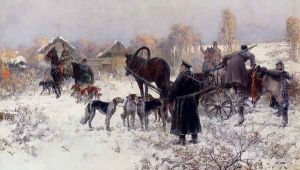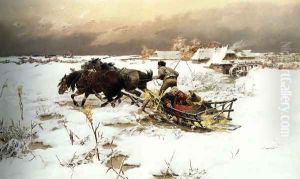Jaroslav Fr. Julius Vesin Paintings
Jaroslav Fr. Julius Vesin was a Czech artist, known for his unique contributions to painting, graphic design, and pedagogy in the late 19th and early 20th centuries. Born on September 23, 1860, in Třebíč, Moravia (then part of the Austro-Hungarian Empire, now the Czech Republic), Vesin was a pivotal figure in the Czech Art Nouveau movement, blending nationalistic themes with modernist aesthetics. His work, characterized by intricate detail, vibrant colors, and often mystical themes, reflects a deep engagement with the folklore and cultural heritage of his homeland.
Vesin's education in art began at the Academy of Fine Arts in Prague, where he studied under the guidance of prominent Czech artists of the time. His early career was marked by a traditional approach to painting, but he soon embraced the emerging Art Nouveau style, which sought to break down the barriers between fine and applied arts, incorporating elements from both into his work. Vesin's paintings often featured allegorical themes, landscapes, and portraits, imbued with a sense of national identity and pride. He was particularly adept at using symbolism to convey deeper meanings, drawing inspiration from Czech myths and legends.
Aside from his artistic creations, Vesin was also a respected teacher and advocate for arts education. He taught at various institutions, where he influenced a generation of Czech artists, instilling in them a sense of purpose and a commitment to incorporating Czech cultural elements into their work. His contributions to graphic design, particularly in the realm of book illustration and poster design, helped elevate the status of graphic arts in the Czech lands.
Jaroslav Fr. Julius Vesin's legacy is that of a pioneer who helped forge a distinct Czech artistic identity at a time of burgeoning national consciousness. His works are celebrated for their technical mastery, imaginative depth, and cultural significance. Vesin passed away on June 3, 1915, in Prague, but his influence on Czech art and national identity endures, marking him as one of the most important Czech artists of his era.

